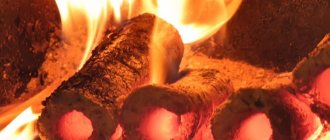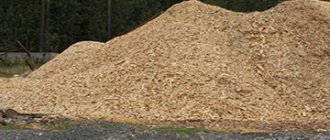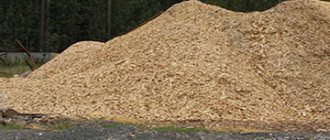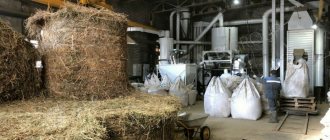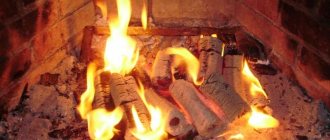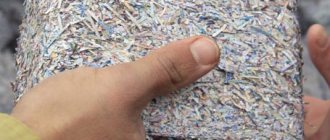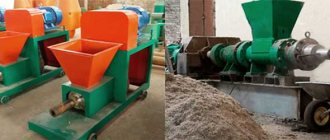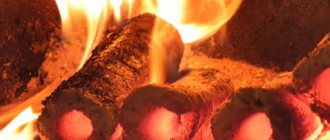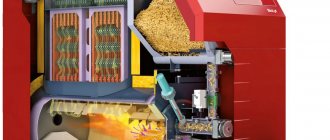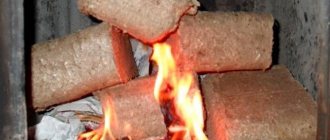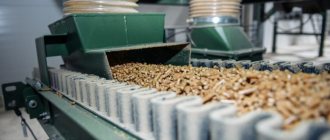Solid fuel stoves can be heated not only with coal or wood; fuel briquettes can be an excellent solution. These briquettes, or Eurofirewood as they are also called, are created from various natural materials, usually the remains of human and animal life.
Wonderful fuel briquettes are made from wood, straw, peat, paper, reeds, nut shells, seeds and their husks (husks). In this article we will try to talk in more detail about the features and characteristics of fuel briquettes made from sunflower husks, which are very popular among the people.
Fuel briquettes made from sunflower seeds and husks
Reviews about burning time
If you decide to purchase fuel briquettes, it is recommended to read reviews about them before going to the store. It is important to take into account that these products, as noted by consumers, are characterized by a significant burning time, which is especially evident when compared with traditional firewood. Thus, loading into heating equipment can be done 3 times less often. Combustion occurs with minimal smoke formation, the material does not spark or shoot. This ensures a constant temperature throughout the entire combustion period. After combustion, charcoal is formed, which is also true for ordinary firewood. In the future, the combustion product can be used for grilling or cooking kebabs.
Reviews about calorific value
Buyers choose fuel briquettes made from sunflower husks, reviews of which you can read in the article, for the reason that their calorific value is much higher compared to ordinary firewood. Practice shows that the mentioned parameter is equal to that of coal. Kebab lovers and grill owners emphasize that when fat gets on the coals formed after burning briquettes, no ignition occurs; the material continues to burn or smolder with a low, even flame. It should be noted that the temperature is constant. Heat transfer is 4400 kcal.
Sunflower husk granulation technology
When making pellets from sunflower husks, the usual algorithm for fuel pellets is used.
The required humidity of the husk is up to 14.5%
. Under normal storage conditions it is already dry enough for granulation.
1. Grinding raw materials in a crusher to a fine fraction.
2. The crushed raw materials go into a storage hopper before granulation.
3. The mass evenly enters the granulator, where it is moistened with water in the mixer-conditioner, after which it is fed into the pressing chamber, from the matrix of which granules subsequently emerge.
4. Since the granules are pressed at high temperatures, they are sent through a conveyor to a cooling column, where they are cooled and screened to separate non-granular particles.
5. Next, the pellets enter the storage bin or are immediately packaged into bags or big bags using a weighing dispenser.
Reviews about environmental friendliness
Fuel briquettes made from sunflower husks, reviews of which you should be interested in before purchasing, are environmentally friendly. It is this characteristic, according to buyers, that largely determines the choice towards the described fuel. All kinds of additives are not used during production, and during combustion no harmful substances are released into the environment; this is especially true when compared with solid fuels with the same calorific value as coal. Ultimately, coal can even be used in the form of mineral fertilizer.
Reviews of sunflower husk briquettes
Fuel briquettes made from sunflower husks, reviews of which will help you make your choice, have many advantages. According to the European classification, such briquettes can be classified as fuel that does not produce smoke. This attracts owners of fireplaces and heating equipment installed inside the house. Consumers also choose these products because they are very compact, which is important not only for a private home, but also for a small country house. Among other things, oversized fuel is very convenient to transport, it is easy to load and unload, and you do not have to pay too much for transport services. Fuel briquettes, reviews of which you will become aware of after reading the article, are suitable for cooking any food in barbecues, barbecues and grills. Due to the fact that the process does not emit carbon monoxide, you can cook food indoors, which applies not only to a residential building, but also to a veranda, restaurant or cafe.
Pros and cons of business
The pellet production business has a number of advantages:
- cheapness of raw materials, in some situations it can be obtained almost free of charge;
- relatively low cost of equipment that allows the production of granules in large volumes;
- environmental friendliness of production;
- low competition.
However, there are also some disadvantages:
- pellets are a relatively new type of fuel, so residents of private houses trust coal and firewood more;
- seasonality of the business - in the summer, the level of sales can drop several times;
- It makes sense to organize production only if there are nearby sources of raw materials, for example, wood processing plants and sawmills.
Reviews of reed briquettes
If you are interested in fuel briquettes made from reeds - who fired them, reviews and other information - you can read all this below. Buyers claim that 1 kilogram of material will be enough for 7 hours of continuous burning. In this case, the heat transfer will be 6550 kcal/kg. Owners of boiler equipment say that they will only have to clean the device once every two years. The resulting ash, like coal, can be used as an environmentally friendly fertilizer.
You can ensure autonomy by using such fuel, since the equipment will not depend on companies supplying electricity and gas. There is no dependence on external conditions such as damage to pipelines, power lines, theft, etc. Consumers do not face the need for lengthy approvals, which are carried out before connecting electrical or gas equipment.
Fuel briquettes made of reeds, reviews of which have something in common with positive characteristics, have a high density. The production process uses technology that involves screw pressing. As a result, it is possible to achieve a density ranging from 1.1 to 1.2 t/m3. The surface consists of a fairly strong crust, which prevents damage and rupture of the briquette during transportation and storage. Transportation can be carried out by laying the products in two tiers, since the material almost does not form crumbs. The existing crust can reduce the penetration of moisture inside, which makes the use of briquettes more comfortable.
Financial plan
Investments in a business project
To organize production, the following investments in rubles are needed:
- registration of an enterprise – 10,000;
- certification – 30,000;
- production line – 2,950,000;
- transportation, installation and commissioning of equipment – 590,000;
- additional inventory – 100,000.
Total: 3,000,000 rubles
Current expenses
Monthly costs for the production of each ton of fuel in rubles will be:
- raw materials – about 750;
- electricity – 450;
- salary – 400;
- depreciation – 240;
- packaging and transportation – 120;
- other expenses (rent, transportation, etc.) – 200.
Total: 2160 rubles.
Sales revenue
The productivity of the mini-plant with a standard eight-hour working day allows the production of up to 60 tons of pellets per month. The wholesale cost of a ton of products is about 6 thousand rubles. As a result, your monthly income will be 6000x60=360000 rubles.
The cost of producing 60 tons of pellets will be 2160x60=129600 rubles. Thus, the net profit will be 360,000-129,600 = 230,400 rubles.
Reviews of Pini-Kay briquettes
Pini-Kay fuel briquettes, reviews of which in most cases are only positive, are distinguished by the fact that they do not stain the surface that comes into contact with them during transportation and storage. High density can also be distinguished, which is equivalent to 1200 kg/cubic meter.
Ash content can reach 3%, which is one of the lowest values. If we additionally talk about density, then it is 2.5 times higher than this parameter characteristic of wood. The bulk density of the material is 1000 kg/cubic meter. These figures are of interest to consumers quite often; buyers compare this indicator with bulk density, which is 300 kg/cub.m. This indicator, according to the owners of heating equipment, makes it easy to transport material over impressive distances. Thanks to the ideal shape, as well as small dimensions, it is possible to tightly stack the briquettes on pallets, pouring them through special sleeves if necessary. This allows you to fully automate the process of loading and unloading, as well as further combustion of this type of fuel.
Pini-Kay fuel briquettes, reviews of which you will become aware of after reading the article, should be stored separately from other substances and materials. If the conditions are met, the products can be stored indefinitely until the time of use. The temperature in the indoor warehouse should be equal to the limit from +5 to +40 degrees. In this case, the relative humidity can vary from 30 to 80%. Interaction of products with water and aggressive substances should be avoided. Consumers claim that to extend shelf life it is necessary to exclude exposure to ultraviolet radiation.
Production technology
The raw material for pellets can be not only shavings with peat, but also waste from the agricultural industry: corn cobs, legume pods, sunflower husks, etc. Straw, reeds, sugar cane, bushes and other plant material are also often used.
The production of pellets occurs in several stages:
- Preparation of raw materials – the material is crushed using special crushing equipment. As a result, the sizes of all particles do not exceed 3-4 mm. Then the raw materials are dried in a special chamber, the temperature inside of which reaches 400 degrees. The humidity level is adjusted to 10-12%. During the drying process, it is extremely important not to overheat the raw material so that it does not lose lignin, a natural wood glue. Otherwise, you won’t be able to get granules.
- Adding steam is necessary for the process of forming granules from raw materials.
- Forming - a special machine called a granulator is used. The machine is a system that includes re-grinding knives and a press. The shape and size of the granules are determined by the matrix forms.
- Cooling - when the formed mass cools, the lignin hardens, as a result of which the granules gain the necessary strength.
- Sorting - finished products are packaged in special bags (big bags) of 1000 kg or in consumer containers - bags up to 25 kg.
- Storage – products are kept in dry and ventilated areas, and packages must be placed on pallets.
Reviews about RUF briquettes
RUF fuel briquettes, reviews of which correspond to the characteristics of the material, are easily decomposed. Owners of fireplaces, boilers, and stoves note that when using another type of fuel, they have to turn into a fireman, ensuring that fuel is added every hour. In order to ensure smoldering, you need to reduce the draft by closing the vent. When melting the equipment, you need to ensure a slight draft, then a cold plug will be formed in the chimney, and the briquette will not smoke.
In this case, it is possible to melt the device without preheating the air duct. Using RUF fuel briquettes, reviews of which will be useful to read before visiting the store, you can warm up the room in a shorter time than using traditional firewood.
Features of using briquettes "RUF"
“RUF” fuel briquettes, reviews of which would be useful to read for any owner of heating equipment that requires ignition, are distinguished by certain characteristics. For example, knowing that heat transfer is 4500 kcal/kg, you can heat a house with an area of 45 square meters within one hour using one briquette. The weight of the latter should be one kilogram. Thus, to obtain 10,000 kcal it will be necessary to use 5 tons of firewood, of which almost half will be with water. To obtain an equivalent amount of heat, you will need to use briquettes in a volume that varies from 1.5 to 2.2 tons. In view of all the above characteristics, it can be noted that the storage and transportation of briquettes will require an area 2 times smaller than that required for the same purposes using conventional firewood. This indicates that the consumer of briquettes benefits more and receives more impressive efficiency than when purchasing and delivering conventional firewood.
If we compare with coal, then to obtain heat of 10,000 kcal it will be necessary to use the mentioned fuel in a volume of 2.2 tons.
Company organizational plan
The process of organizing the business in question includes several main stages:
- registration of activities;
- search for production premises;
- purchase of equipment;
- selection of personnel and scheduling of the enterprise.
Registration of activities
You can register a business as an individual entrepreneur or LLC. The first option is suitable for a small enterprise focused on the domestic Russian market. If you plan to open a large plant that will produce fuel both for the domestic market and for export, you must register an LLC. This option is also chosen if loans are required to organize a business. The optimal taxation scheme is the simplified tax system.
You do not need to obtain a license to make pellets. If the products are to be exported, it is necessary to follow the provisions of two documents:
- Government Decree No. 442 of 07.2003;
- 1 p. art. 25 of Federal Law No. 206 of June 21, 2014.
In addition, it must be taken into account that pellets must meet EN plus certification standards. To sell fuel on the domestic market, it is also necessary to undergo product certification.
Search for premises
The workshop for the production of pellets must meet the following requirements:
- area of 150 square meters or more;
- lack of dampness;
- effective ventilation;
- compliance with fire safety standards;
- centralized water supply;
- Availability of 380 V power supply.
Advice! It is advisable that the premises be located close to a sawmill or other sources of raw materials. This will save on transportation costs and ensure uninterrupted supply.
Equipment purchase
Pellet production requires the following equipment:
- crusher (chipper);
- drying chamber;
- granulator.
Advice! It is advisable to purchase at least one forklift for supplying raw materials and transporting finished products to the warehouse.
The simplest option is to purchase a line for the production of wood pellets. It includes all the equipment necessary for this.
Personnel and work schedule of the enterprise
To produce pellets, even on a large scale, you will need a minimum of personnel:
- 2-3 line operators;
- loader driver;
- sales manager;
- accountant;
- Shift Supervisor.
Such a staff will be required to operate the plant in one shift. If the plant operates on two shifts, an additional team of operators and two shift supervisors will be required.
Additional features of RUF briquettes
In shape, these products resemble bricks, in the manufacture of which minimum requirements are imposed on the qualifications of personnel and the organization of production, which has a positive effect on the cost of the product. Among the disadvantages, we can highlight the least resistance among all other briquettes to moisture and external mechanical influences. Therefore, this brand of fuel requires high-quality packaging; if it is damaged, long-term transportation and storage become impossible. This is especially true for CIS roads, the level of which does not correspond to European ones.
Search for pellet sales channels
The main consumer of pellets on the domestic market is the energy sector - fuel is purchased by boiler houses and power plants. In addition, the products are in demand by private households, especially in holiday villages. It is often purchased by manufacturers of cat litter.
You can establish distribution channels by receiving the support of local authorities and housing and communal services managers. Pellets can be used to heat schools, kindergartens, hospitals and multi-storey buildings. To promote your products, you can offer the installation of boilers in municipal institutions, even free of charge, but with the conclusion of an agreement for the subsequent supply of fuel.
To export pellets, you can contact special organizations that are present in almost every region. They help domestic entrepreneurs enter foreign markets.
Reviews about Nestro briquettes
Nestro fuel briquettes, reviews of which will become known to you if you read the information below, have a wide range of uses. They are used when it is necessary to operate industrial equipment, as well as in railway transport. The bars can have an 8-sided shape with a hole located inside. The length of the product is 250 millimeters, while the cross-section is square and has a side within 65 millimeters. The diameter of the circle is equivalent to 70 millimeters, and the hole has a diameter of 20 mm. The humidity of the product upon delivery should not exceed 9%, while the maximum value varies within 7%. Ash content is minimal and amounts to 0.5%.
Consumers like the presence of a technological hole inside the products, which contribute to more intense combustion, without requiring forced ventilation. This makes it possible to use fuel in equipment that has low thrust. The products are manufactured using the technology of shock-mechanical pressing of husks and sawdust. The main difference between such briquettes is the absence of treatment under the influence of temperature during pressing. If there is a need to use briquettes of a certain shape, then these requirements can be taken into account by the manufacturer.
Manufacturing is carried out using connecting rod mechanical or hydraulic presses. Fuel quite often has a cylindrical shape, and among the negative and positive characteristics one can highlight the same features that are characteristic of RUF brand materials. The cost of such products is relatively low due to the fact that the production process is inexpensive. Consumers note that from the point of view of technical features, these briquettes are inferior in many qualities to Pini & Kay brand fuel.
